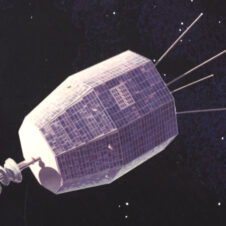New simulation work from ICRAR’s Dr Kenji Bekki has predicted that globular clusters, collections of hundreds of thousands of stars inside galaxies, used to be much larger; up to five times more massive than they are today.
“It’s been a long standing problem how globular clusters were formed in the ancient history of our Galaxy,” said Dr Bekki.
“Our new, state-of-the-art, computer simulations have revealed that these old, dense stellar systems were formed for giant molecular clouds, more than a million times the mass of our Sun, and were initially up to five times more massive than we see today.”
“We’ve shown that globular clusters were initially composed of many smaller star clusters, interacting until they merge to form a central massive cluster that we see today.”
The gas (left) and stars (right) shown in a simulation of globular cluster formation. Smaller groups of stars are seen interacting and merging together to form the final cluster over millions of years of cosmic time. Credit: Dr Kenji Bekki, ICRAR.
DOWNLOAD THE ANIMATION IN HIGHEST RESOLUTION
The globular clusters we see peppered throughout the Milky Way would have formed anywhere from 10 to 12 billion years ago, and would have been surrounded by faint halos of stars.

A forming globular cluster from Dr Bekki’s simulations. The smaller groupings of stars that go on to form the final cluster are still evident in this snapshot. Credit: Dr Kenji Bekki, ICRAR
Dr Bekki’s work also predicts that Globular Clusters will have been forming their own stars over multiple generations and approximately 100 million years, rather than just forming from collections of existing stars coming together.
“Our simulations show that energy input from supernovae, exploding dying stars, and other, older stars, plays a key role in the star formation and movement of gas within newly forming globular clusters,” said Dr Bekki.
“Although globular clusters are very tiny compared to galaxies, they can still build up their tiny stellar systems with low-level star formation.”
Published in the Monthly Notices of the Royal Astronomical Society published by Oxford University Press, the paper ‘Globular cluster formation with multiple stellar populations: self-enrichment in fractal massive molecular clouds’ is available to download from the journal website.


